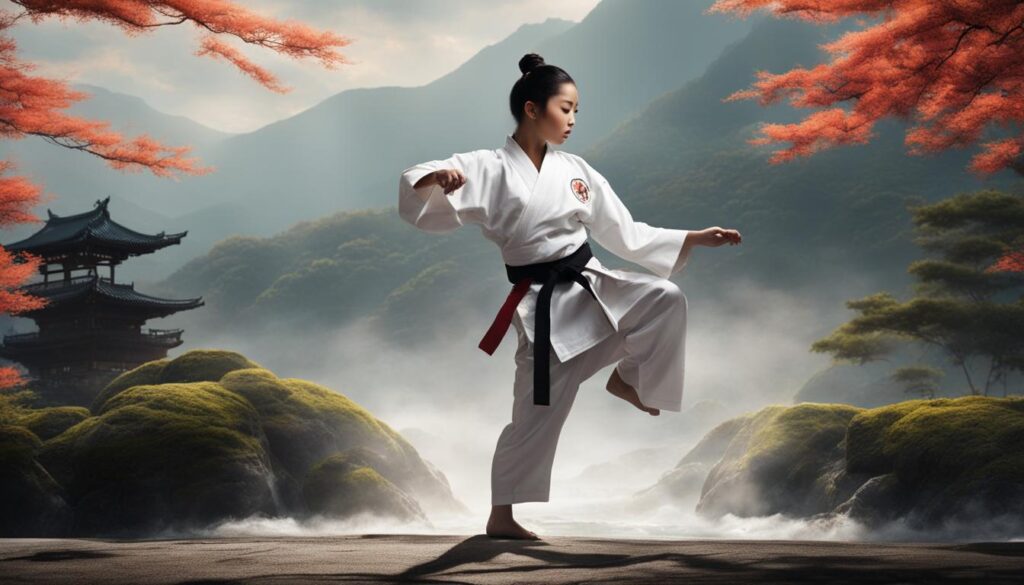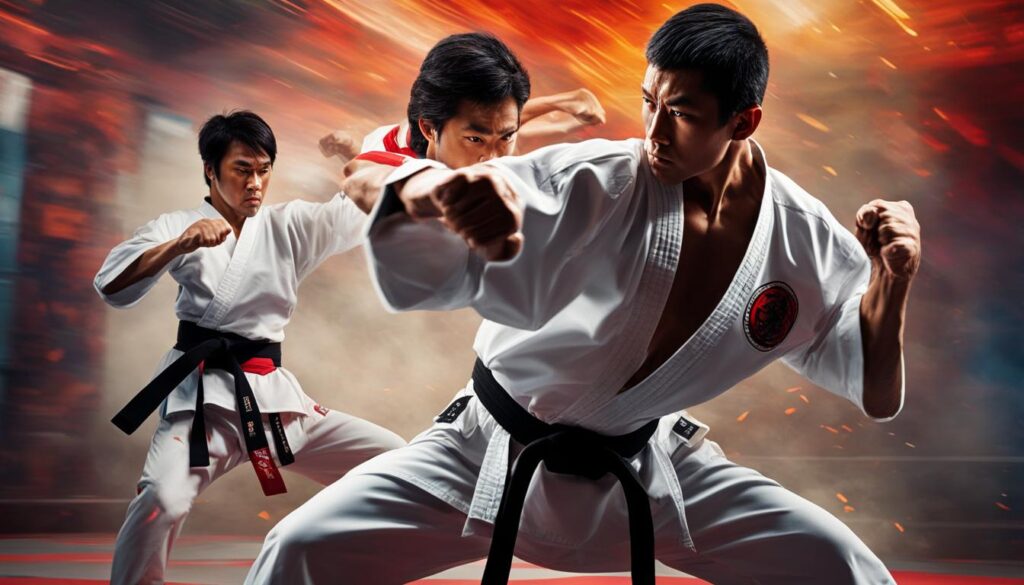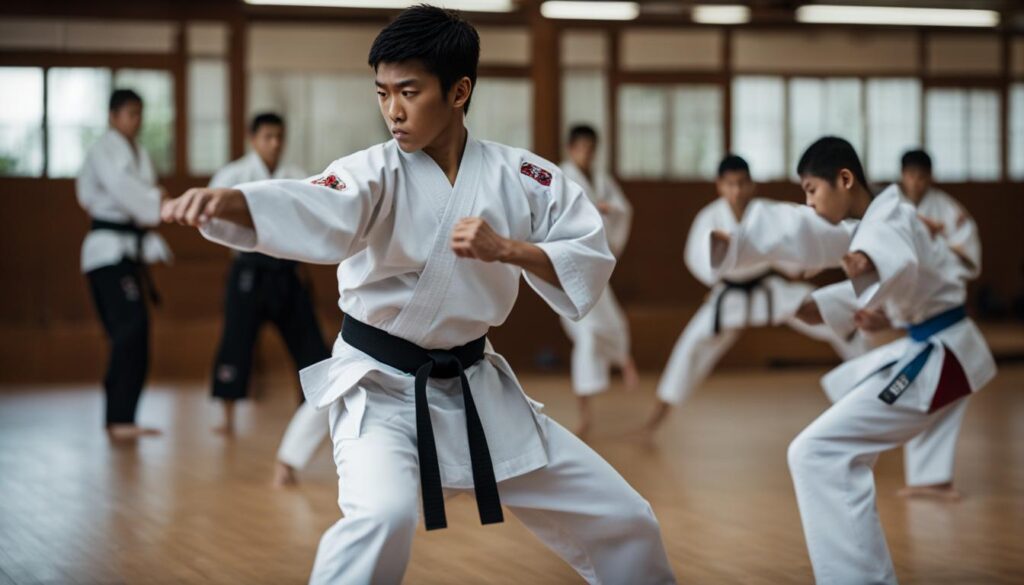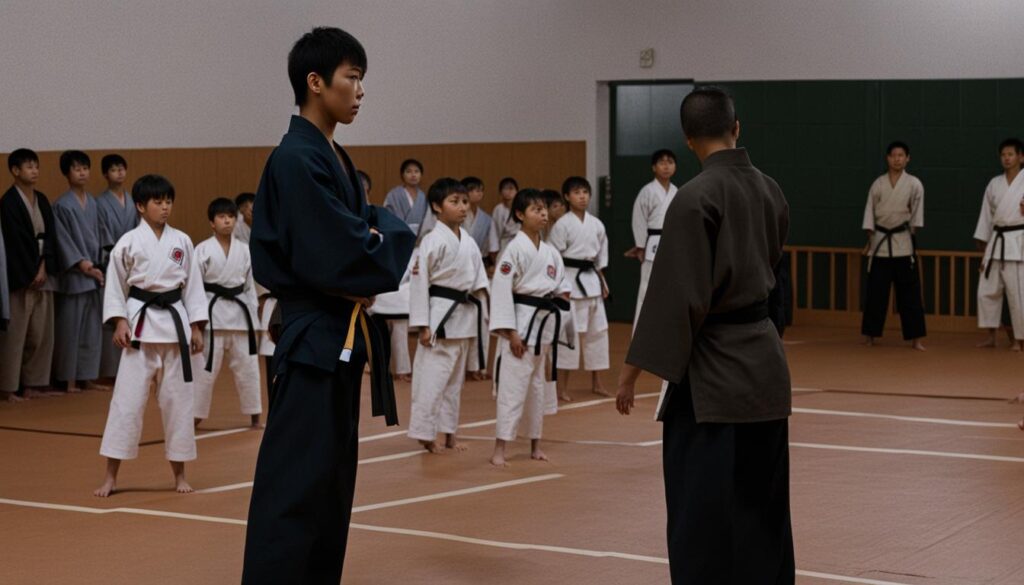Welcome to our beginner’s guide on how to do karate! Karate is a martial art that combines physical techniques with mental discipline. Whether you’re interested in self-defense, fitness, or personal growth, karate offers a comprehensive approach. In this guide, we will take you through the essential steps and techniques required to start your karate journey.
Key Takeaways:
- Prepare your mind and body through meditation, warm-ups, and stretching.
- Understand the philosophy of karate, which emphasizes peace, humility, and personal development.
- Master the basic stances and footwork to build a strong foundation.
- Learn the variations of the ready stance to mentally and physically prepare for sparring or training.
- Develop balance and body alignment to execute powerful strikes and blocks in karate.
Now that you have a brief introduction to the world of karate, let’s dive deeper into each aspect of training and learn how to perform karate techniques with precision and efficiency. Let’s begin our journey towards becoming a skilled karate practitioner!
Getting Started with Karate
Before diving into the techniques of karate, it is important to establish a strong foundation. Learning the basic stances is essential as they form the groundwork for effective kicks, strikes, and blocks. There are different types of stances in karate, including the natural stance (shizentai-dachi), front stance (zenkutsu-dachi), and cat stance (nekoashi-dachi). Each stance has its specific purpose and body positioning.
Shizentai-dachi (Natural Stance): This is the starting position in karate, where the feet are shoulder-width apart, and the arms are relaxed by the sides of the body. This stance provides a neutral and balanced position from which to execute various techniques.
Zenkutsu-dachi (Front Stance): In this stance, one leg is positioned forward with a bent knee, while the other leg is extended behind, providing stability and power. It is commonly used for powerful strikes and forward movement.
Nekoashi-dachi (Cat Stance): This stance resembles a cat ready to pounce, where the majority of the body weight is supported by the back leg, with the front foot lightly touching the ground. It allows for quick changes in direction and agility.
By mastering these basic stances, beginners can develop a solid foundation in karate and set themselves up for success in learning more advanced techniques.
Mastering the Ready Stance
The ready stance is a fundamental element of karate that serves as the starting position before engaging in a fight or training session. It is essential for beginners to understand and master the ready stance as it sets the foundation for their karate journey. The ready stance not only prepares the karate practitioner physically but also mentally, providing a focused and prepared mindset.
There are different variations of the ready stance depending on the series in karate, such as the Fukyugata series, Pinan series, and Naihanchi series. These series have their unique foot and toe positioning, allowing practitioners to learn and adapt to specific forms and techniques within each series. Mastering these variations of the ready stance is crucial for effective execution of karate forms and movements.
By mastering the ready stance, beginners in karate can enhance their balance, stability, and overall performance. The proper alignment of the feet, legs, and body in the ready stance allows for better control of movements and techniques, ensuring that karate forms are executed with precision and power.
Practicing the ready stance regularly during karate training sessions helps develop muscle memory, enabling practitioners to transition seamlessly into other techniques and combinations. It also promotes a disciplined approach to training and reinforces the core principles of karate, such as focus, discipline, and respect.
In conclusion, mastering the ready stance in karate is essential for beginners as it lays the groundwork for their karate journey. By understanding and practicing the variations of the ready stance, practitioners can improve their technique, balance, and overall performance in karate forms and movements.
Achieving Balance in Karate
Balance is a crucial element in karate as it enables practitioners to deliver powerful strikes and execute precise kicks. It plays a fundamental role in maintaining stability and mobility during combat. For effective defense and counterattacks, karate training emphasizes quick shifts in balance. Developing balance requires consistent practice and a strong focus on body alignment.
One of the key aspects of achieving balance in karate is maintaining a low center of gravity. This allows practitioners to generate power from their legs and deliver forceful techniques. By keeping the center of gravity low, karateka can enhance their stability and make it harder for opponents to throw them off balance.
Another essential aspect is finding the right balance between stability and mobility. Having a solid base contributes to stability, allowing practitioners to react swiftly and maintain control during movements. At the same time, maintaining some degree of flexibility and mobility enables quick transitions and better adaptability to different situations.
“Balance is not something you find, it’s something you create” – Junjie Hu
In karate, mastering balance is particularly important because it enables efficient weight shifting and body positioning, helping practitioners deliver powerful techniques while maintaining stability. Having a well-balanced stance also enhances the effectiveness of blocks, enabling practitioners to absorb and redirect the force of incoming strikes.
Practicing balance exercises can significantly improve one’s overall karate skills. Exercises such as standing on one leg, performing kicks on a balance board, or practicing slow and controlled movements with a focus on stability can help develop a strong sense of balance and body awareness.
Moreover, maintaining proper body alignment is paramount. It ensures that weight is distributed evenly and that movements are efficient. Attention should be paid to the alignment of the head, shoulders, hips, and feet. Incorrect alignment can lead to imbalance and inconsistencies in technique execution.

By dedicating time and effort to improving balance, karate practitioners can enhance their overall performance and become more effective martial artists.
Harnessing Power and Speed in Karate
Karate is a dynamic martial art that emphasizes the effective use of power and speed. Unlike relying solely on muscle strength, karate practitioners harness the full potential of their bodies to generate powerful strikes and swift movements. By understanding the principles of power and developing precise techniques, karate practitioners can maximize the impact of their actions.
One of the key aspects of generating power in karate is the efficient utilization of the entire body. Rather than relying on isolated muscle groups, karate techniques involve the integration of all body parts, from the legs and hips to the arms and torso. This unified movement allows practitioners to channel their energy and transfer it effectively into strikes and blocks.
Speed also plays a crucial role in the execution of karate techniques. By training to move swiftly and with precision, practitioners can surprise opponents and deliver lightning-fast strikes. It is important to note that speed is not just about being fast but also about maintaining control and accuracy. In karate, speed without precision can diminish the effectiveness of techniques.
“Karate is like boiling water; if you do not heat it constantly, it will cool.” – Gichin Funakoshi
Karate training focuses on developing the combination of power and speed through disciplined practice. By continuously refining techniques and implementing proper body mechanics, practitioners can enhance the impact of their strikes and improve their overall performance.
| Technique | Description |
|---|---|
| Snap Punch | A quick and powerful punch delivered with a straight arm and a rapid extension of the fist. |
| Roundhouse Kick | A circular kick that generates power through rotation of the hips and extension of the leg. |
| Spinning Back Fist | A strike delivered by rotating the body and throwing a punch with the back of the fist. |
By mastering the coordination of power and speed, karate practitioners can achieve remarkable effectiveness in their techniques. Through dedicated training and cultivation of proper body mechanics, practitioners can deliver powerful strikes with lightning speed, making karate an impressive martial art.
Perfecting Punches and Blocks
In karate, punches and blocks are fundamental techniques that every practitioner must master. By practicing various types of punches and honing your blocking skills, you can enhance your striking effectiveness and defensive abilities. Let’s explore the key aspects of perfecting punches and blocks in karate.
Punches
There are several types of punches in karate, each with its own purpose and application. Some common punches include:
- Straight punch
- Uppercut
- Knife-hand strike
- Spear-hand strike
- Elbow strike
- Backfist
By practicing these punches, you can develop precision, speed, and power in your strikes. It is crucial to maintain proper form while punching, including keeping your wrist straight and aligning your striking arm and body correctly. This ensures optimal force transmission and reduces the risk of injury.
Blocks
Blocks are equally important in karate, as they allow you to defend against incoming attacks and create opportunities for counterattacks. Some essential blocking techniques include:
- High block
- Low block
- Inside block
- Outside block
- Knife-hand block
- X-block
Mastering these blocks requires dedicated practice and attention to detail. Focus on proper body positioning, alignment, and timing to execute the blocks effectively and efficiently. Remember, blocks are not only about stopping an attack but also redirecting the force to neutralize the threat.
By perfecting punches and blocks in karate, you will develop a well-rounded skill set that contributes to your overall martial arts proficiency. Regular practice and refinement of these techniques will enhance not only your physical abilities but also your mental focus and self-discipline.

| Punches | Key Points |
|---|---|
| Straight punch | Maintain straight wrist and follow-through with the entire arm. |
| Uppercut | Generate power from the legs and use the entire body to deliver an upward strike. |
| Knife-hand strike | Focus on striking with the edge of the hand and maintaining a strong hand position. |
| Spear-hand strike | Drive the fingertips forward with intensity and precision. |
| Elbow strike | Utilize proper body mechanics to generate force with the elbow. |
| Backfist | Execute a quick, snapping strike with the back of the hand. |
| Blocks | Key Points |
|---|---|
| High block | Raise the forearm diagonally to defend against high-level attacks. |
| Low block | Lower the forearm to protect against low-level strikes. |
| Inside block | Use the inside of the forearm to block incoming attacks from the inside. |
| Outside block | Use the outside of the forearm to deflect attacks from the outside. |
| Knife-hand block | Form the hand into a knife-hand position to intercept and redirect strikes. |
| X-block | Create an X-shaped barrier by crossing the forearms to defend against multiple attacks. |
Mastering Powerful Kicks
Karate is known for its dynamic and explosive kicks, which require a combination of strength, flexibility, and precision. By mastering these essential kicking techniques, practitioners can enhance their martial arts skills and elevate their performance. Let’s explore some of the fundamental kicks in karate and learn how to execute them effectively.
Front Snap Kick: This kick involves extending the leg forward using the ball of the foot to strike the opponent. It targets the midsection and can be executed with speed and accuracy.
Side Snap Kick: The side snap kick is delivered by quickly extending the leg to the side and striking with the blade of the foot. It is a versatile kick used for targeting the ribs or the head of an opponent.
Side Thrust Kick: This powerful kick is executed by thrusting the leg sideways and striking with the heel. It is commonly used to target an opponent’s hip, knee, or thigh, delivering significant impact.
Back Thrust Kick: Also known as the reverse thrust kick, this technique involves driving the foot backward and striking with the heel. It can be used to counter an opponent’s attack from behind or to create distance.
Round Kick: The round kick utilizes a circular motion, extending the leg sidewards and then snapping it forward to strike the target with the top of the foot or shin. It is a versatile kick that can target various areas, including the ribs, head, or legs.
Developing powerful kicks in karate requires consistent practice, proper form, and focus on engaging the correct muscle groups. By combining strength, speed, and accuracy, practitioners can execute kicks that are both visually impressive and effective in combat situations. Remember to maintain proper body alignment, keep your guard up, and choose the right kick for the situation.
| Kick | Description |
|---|---|
| Front Snap Kick | Extend the leg forward using the ball of the foot to strike the opponent’s midsection |
| Side Snap Kick | Extend the leg to the side and strike with the blade of the foot, targeting the ribs or head |
| Side Thrust Kick | Thrust the leg sideways, striking with the heel to target the opponent’s hip, knee, or thigh |
| Back Thrust Kick | Drive the foot backward and strike with the heel, useful for countering attacks from behind or creating distance |
| Round Kick | Extend the leg sidewards and snap it forward in a circular motion to strike with the top of the foot or shin |
With dedicated training and focus on technique, beginners can gradually improve their kicking skills in karate. Incorporate these kicks into your practice sessions and work on developing strength, flexibility, and accuracy. Remember, mastering powerful kicks requires patience and perseverance. So keep practicing and never underestimate the impact of a well-executed karate kick!
Sparring and Self-Defense
As karate practitioners progress in their training, they have the opportunity to engage in sparring and self-defense practices. Sparring not only improves stamina and agility but also enhances the ability to execute combinations effectively. It provides an invaluable experience that simulates real combat situations, allowing practitioners to test their skills and develop practical fighting strategies.
During sparring sessions, karateka learn to read their opponents, anticipate their movements, and respond quickly with precision. This helps them develop better reflexes, coordination, and overall body awareness. Regular sparring also fosters adaptability and the ability to think critically under pressure.
Self-defense techniques are another essential aspect of karate training. They equip practitioners with the necessary skills to protect themselves in real-life scenarios. Karate emphasizes practical self-defense techniques that can be used against various types of attacks.
Some common self-defense techniques in karate include:
- Wrist grabs and escapes
- Chokes and holds countermeasures
- Defense against weapon threats
These techniques are taught and practiced in a controlled environment to ensure safety. By mastering self-defense techniques, karate practitioners gain confidence, become more aware of their surroundings, and develop the ability to react effectively in dangerous situations.
Sparring and self-defense training should be an integral part of any karate practitioner’s journey. These activities not only enhance physical fitness but also foster mental resilience, discipline, and self-confidence. Through consistent practice and guidance from experienced instructors, students can develop practical fighting skills and gain a deeper understanding of the principles underlying karate as a self-defense system.
Mastering Kata
Kata, or practice form, is a key component of karate training. It consists of a series of predetermined movements and techniques that are performed in a specific pattern. Kata training helps refine and improve technique, timing, and precision. By practicing kata, karate practitioners develop muscle memory and enhance their overall skills.
When performing kata, practitioners follow a set sequence of movements that simulate different combat scenarios. Each kata has its own unique rhythm and flow, allowing practitioners to express their individual style and adaptability. Through continuous practice, karateka can refine their technique, improve their focus, and develop greater control over their movements.
One of the benefits of kata training is its applicability to self-defense situations. The movements and techniques learned in kata can be directly applied to real-life scenarios, helping practitioners react quickly and effectively. Kata also encourages mental discipline and concentration as practitioners strive to execute each movement with precision and intention.
To master kata, it is important to start with the basic forms and gradually progress to more advanced ones. As practitioners become proficient in one kata, they can move on to learning new ones, expanding their repertoire and deepening their understanding of karate as a martial art.

By regularly practicing kata, karate practitioners can experience profound personal growth and development. The combination of physical movements, mental focus, and spiritual awareness cultivates a sense of harmony within the practitioner. Kata serves as a form of meditation in motion, allowing practitioners to connect with their inner selves and embrace the essence of karate.
Testing and Advancement
Testing plays a vital role in the journey of karate training. It serves as a way to assess a practitioner’s progress and determine their eligibility for belt advancement. Each belt level has specific requirements and criteria that must be met to demonstrate proficiency in techniques, forms, and sparring. By successfully completing a test, practitioners have the opportunity to showcase their skills and receive recognition for their dedication and hard work.
Advancement in karate is not solely based on physical ability but also on continuous learning, practice, and commitment to personal growth. It is a reflection of the practitioner’s development both in and outside the dojo. By consistently challenging themselves and striving for improvement, individuals can progress through the belt system, symbolizing their increasing knowledge and skill in karate.
Testing provides a meaningful way to measure progress and set goals for further development. It serves as a motivator, encouraging practitioners to push their boundaries and reach new heights. Beyond the acquisition of belt ranks, testing enhances self-confidence, perseverance, and resilience, qualities that are essential both in martial arts and in life.
Testing Requirements
The specific testing requirements may vary depending on the karate style or organization. However, some common elements are typically assessed during a karate test:
- Techniques: Demonstrating proficiency in various strikes, kicks, blocks, and stances.
- Forms: Performing kata, a series of prearranged movements and techniques, with precision and fluidity.
- Sparring: Applying learned techniques in controlled combat situations.
- Spirit and Attitude: Displaying discipline, respect, and a positive mindset throughout the test.
Practitioners are evaluated by experienced instructors and may be required to perform in front of a panel or in a group setting. The specific format and structure of the test can vary, but the focus is always on assessing the practitioner’s overall skill level, technique execution, and mindset.
Advancement Opportunities
Advancing through the belt ranks is an accomplishment that showcases a practitioner’s growth and dedication. The belt system provides clear milestones and goals for individuals to strive toward. Advancement opportunities differ depending on the organization or style being practiced.
Typically, the belt system progresses from a beginner level, often marked by a white belt, to more advanced levels, such as brown or black belt ranks. The number of belts and the criteria for advancement can vary, but the journey of a karate practitioner is a continuous pursuit of knowledge and improvement.
Upon reaching the necessary requirements and successfully completing a test, practitioners are awarded the new belt rank, accompanied by a sense of accomplishment and pride. It signifies their advancement in skill and understanding of karate.
Advancement through the belt system in karate should not be seen as the ultimate goal. It is important to remember that the true essence of karate lies in the journey itself and the constant pursuit of self-improvement, self-discipline, and personal growth.

| Belt Level | Color | Description |
|---|---|---|
| White Belt | Beginner | The starting point for all new karate practitioners. |
| Yellow Belt | Indicates the growth of the seed as the karate skills start to bloom. | |
| Orange Belt | Represents the sun rising and illuminating the path towards further learning. | |
| Green Belt | Symbolizes the growth of a plant as the karate techniques become more refined. | |
| Blue Belt | Represents the sky and the expansion of knowledge and abilities. | |
| Brown Belt | A stage of maturity and experience, where practitioners deepen their understanding of karate. | |
| Black Belt | The ultimate achievement, symbolizing mastery and the beginning of a new journey. |
Conclusion
Karate is a martial art that provides a comprehensive approach to physical and mental development. For beginners looking to start their karate journey, it is important to understand the principles and techniques of this ancient discipline. By following proper training methods and dedicating oneself to practice, beginners can experience the rewards of self-improvement and self-defense.
The path of karate requires discipline, perseverance, and dedication, but the benefits extend far beyond physical fitness. The philosophy of karate is deeply rooted in values such as peace, respect, and humility. It encourages practitioners to continuously strive for personal growth in both mind and body.
Whether your goal is to become a black belt or simply acquire self-defense skills, karate offers a path for individuals of all ages and fitness levels. It fosters mental clarity, physical strength, and emotional well-being. By practicing karate techniques and embracing its principles, beginners can embark on a fulfilling journey of self-discovery and transformation.
So take the first step, and begin your karate training today. Explore the vast array of techniques, train diligently, and embrace the spirit of karate. Discover the power within you, and unlock your true potential through the art of karate.
FAQ
What is karate?
Karate is a martial art that focuses on physical and mental discipline.
How should I prepare before starting karate training?
It is important to meditate, warm up, and stretch your muscles to prepare your mind and body for karate.
What are the basic stances in karate?
The basic stances in karate include the natural stance, front stance, and cat stance.
What is the ready stance in karate?
The ready stance is the starting position in karate before engaging in a fight, and it varies depending on the karate series.
How important is balance in karate?
Balance is crucial in karate as it enables practitioners to execute powerful strikes and defend against attacks effectively.
How can I develop power and speed in karate?
Utilizing the full body and generating speed through longer routes can result in more powerful strikes. Precision and control are also important for executing techniques with speed and accuracy.
What are the fundamental punches and blocks in karate?
The fundamental punches in karate include the straight punch, uppercut, knife-hand strike, spear-hand strike, elbow strike, and backfist. Blocking techniques are important for defense and counterattacking.
What are the basic kicks in karate?
The basic kicks in karate include the front snap kick, side snap kick, side thrust kick, back thrust kick, and round kick.
How does sparring and self-defense training benefit karate practitioners?
Regular sparring and self-defense training improve stamina, agility, and the ability to execute combinations. They also prepare practitioners to defend themselves against multiple attacks or attackers.
What is kata training in karate?
Kata, or practice form, is a series of predetermined movements and techniques performed in a specific pattern. It helps refine and improve technique, timing, and precision.
How does testing work in karate training?
Testing assesses a practitioner’s progress and determines eligibility for belt advancement. Each belt level has specific requirements and criteria that must be met to demonstrate proficiency in techniques, forms, and sparring.
What does karate offer in terms of physical and mental development?
Karate offers a holistic approach to physical and mental development, emphasizing peace, respect, humility, and the continuous pursuit of personal growth.
